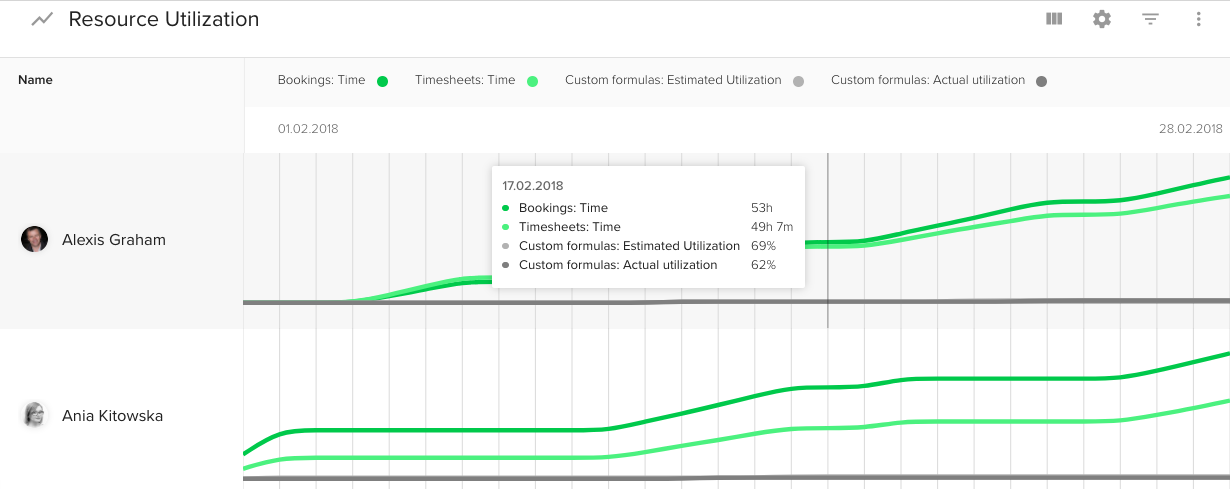资源日历--用一个工具管理整个团队
资源日历(或项目管理日历、或项目规划日历、资源规划软件)可让您更有效、更高效地规划、管理和分配资源--尤其是如果 Microsoft Excel 在您的项目中发挥了主导作用。
公司通常会在以下方面投入大量精力 资源分配.你既要让每个人都忙起来,又要确保他们的任务对公司有价值(这通常意味着要计费)。随着团队的壮大,这一点变得非常棘手,尤其是当您需要同时为多个项目分配人手时。
文章包含
衡量资源利用率的几个公式
资源利用率中的可用性是什么意思
的影响作用 资源管理软件 在资源利用方面
生产性使用和计费使用之间的区别
如何利用资源

检查分配工作是否成功的最简单方法之一就是跟踪团队的利用率和资源容量。在向您介绍各种资源利用率指标和公式之前,我们想先给资源利用率下一个通俗易懂的定义。因此,与其他许多文章一样,我们将在本文中对项目经理使用的定义、含义和术语进行比较。
对员工或资源利用情况的深入了解与 "过度利用 "和 "利用不足 "这两个术语有关。这两个词你都应该注意。为什么?项目期间的工作或职责过多(多任务处理)并不意味着项目会完全完成,也不意味着项目的功能会达到预期。因此,在开始之前,我们先看看 Gartner 的研究结论 如何避免 IT 项目团队负担过重。人员负担过重通常会适得其反,降低绩效,增加失误。Gartner 的研究表明,利用率较低的团队可将交付业务价值所需的时间减少 30% 或更多。了解了这一点,密切关注资源利用率就显得很有意义。

根据项目管理协会(PMI)的定义,项目管理被理解为使用特定的知识、能力、技能、设备、工具、软件、流程和技术来产生 "对人们有价值 "的东西。可以很容易地理解为,项目管理就是利用我们所拥有的一切来做事。精神上和物质上。
而且,如果我们想讽刺一下,我们可以利用 "对人的价值 "这一短语的模糊性,说所提出的项目管理倡议的概念也可以是指创造一个社会运动,包括政治或宗教运动。
但与上述项目管理研究所的定义相比,项目管理协会的建议可谓更为严谨。后者强调时间和预算等无偏见、可衡量的标准。
在商业领域,这两者虽然可以协商,但都规定了一定的项目框架。无论是客户委托的任务,还是公司主管提交给营销部门的任务,都必须在预期时间内完成,或者说,在商业上可行的时间内完成,并产生投资回报。因此,根据 APM:项目管理是应用流程、方法、技能、知识和经验,按照项目验收标准,在商定的参数范围内实现特定的项目目标。项目管理的最终成果受限于有限的时间范围和预算。因此,与单纯的管理相反,如果我们在项目管理中谈论项目,每个项目都包含必须完成的时间和预算等要求。下面举例说明一些项目资源(包含一些要求):
在 24 个月内,以 $.5 亿美元的预算,制造出爆炸力不亚于沙皇原子弹的原子弹
在维斯瓦河上修建大坝,直至 2025 年 3 月 31 日,同时不超过 1.2 亿美元的预算
在 8 周内为一家鞋类制造商开发桌面应用程序(包括转换路径分析和选择最佳应用程序),耗资 12 000 美元
在 $100 000 预算内,在 12 个月内刷新品牌定位(包括新的 BTL 材料分发)。
通过上面的例子,我们可以想象每个项目涉及的步骤、行政任务和程序有多么多。每个项目需要多少具备相关技能的人员?
因此,如上所述,项目管理就是流程的应用。或者我们可以直截了当地说:项目就是一个过程。这个过程被命名为项目管理生命周期。在互联网上可以找到这个过程的 3 个、4 个、5 个、甚至 6 个和 7 个阶段。但最流行的是属于上述 PMI 的 5 个阶段。

如您所见,每个阶段都是一组任务,每个阶段背后都有许多不同的问题和挑战。还值得补充的是,尤其是对于那些刚开始担任项目经理的人来说,这些阶段不应总是按照时间顺序来处理。有些要素可以提前开始,而有些要素则是项目过程中的一个持续过程(例如绩效管理,或者更准确地说,与本文主题相关的资源规划工具的使用)。在整个过程中,每个过程都会以某种方式进行优化。资源调配是一项重要技术,用于在项目生命周期内平衡资源分配,避免过度利用或利用不足。
回到正题,在项目管理的生命周期过程中,资源利用率在哪里很重要?
在流程的 5 个阶段中,资源利用属于第三阶段。它是监测和控制阶段的一部分,准确地说,是绩效管理的一部分。
启动和构想
规划
启动和执行
监测与控制 它包括性能检查,即资源利用率
项目关闭
对领导者而言,资源利用率是绩效管理中最有价值、最有用的指标和关键绩效指标。

众所周知,资源规划和资源调度是确保项目计划顺利进行的关键。有效利用资源是这些难题的另一个部分,或者我们想说的是资源管理。资源分配指的是--说得简单点--为某项任务分配技术资源,而资源利用率则衡量该资源在分配任务期间所花费的时间(计费或战略工作、非计费时/分、管理时/分等)的有效性。

资源利用率是指帮助项目经理和资源经理了解员工在项目期间如何使用时间的指标。有了这些知识,他们就能做出更有效的资源配置判断和决策,从而提高生产率和盈利能力。资源利用率衡量每个员工的生产率和/或整个团队的利用率。它可以监控员工是否被过度利用或利用不足,并确定工作量管理政策。
更准确地说,从项目经理和企业的角度来看,计算资源利用率是一个术语,用于描述员工可用时间中用于计费任务或项目的百分比。资源利用率显示了团队有多少时间用于计费任务,以及每个团队成员的工作效率如何。资源预测可帮助项目经理根据当前的利用率指标预测未来的资源需求。
换句话说,资源利用率是一个衡量指标,它显示了你的整个团队或特定员工是否满员。它指的是规划项目和充分利用公司现有资源的过程。
例如,当你知道某个人已经被过度使用,而且他的头顶上有太多的任务时,你就可以寻找其他具有类似技能的人,以适应你的项目。这一指标还有助于确定哪些人员未得到充分利用,以便为他们分配新项目。

唯一的办法就是浏览各种选项,选择最适合自己需求的一种。资源优化技术有助于提高资源利用率计算的效率和准确性。
典型的资源利用公式是
该值以百分比表示,显示团队有多少时间用于工作。
尽管听起来简单明了,但在衡量资源利用率时还是会出现一些问题。您是否应该根据实际工作时间 (时间表还是计划工作时间?假期和 带薪休假?您到底应该多久跟踪一次团队的资源利用计划?一个定义明确的资源分配策略可以极大地影响资源利用率计算的准确性。

答案是:视情况而定。变数太多,几乎不可能推荐一个放之四海而皆准的解决方案。唯一的办法就是仔细研究各种选项,选择最适合自己需求的方案。
衡量资源能力利用率的一种方法是将其可用性与计划工作时间进行比较。
有效的资源调度对于确保预订与团队可用性保持一致至关重要。

这种方法的主要优点是,如果得分过低,您仍然可以优化您的计划。查看您的计划表,看看您的项目计划是否正确。全面的资源分配计划有助于确保所有资源得到有效利用,并将缺口降至最低。也许有些人的预约时间有空档,或者你有两个开发人员每周在一个项目上工作 4 小时,而你本可以让一个人全职工作?
想办法填补团队日程安排中的空白。也许你应该启动一个研发项目或引入创新休假?这不仅能帮助您避免生产力的损失,而且也是保持员工参与度的好方法。 对员工来说,利用率不足比你意识到的更令人沮丧.
注意不要让员工忙得不可开交。他们有可能无法按时完成任务(另外,你也不希望他们精疲力竭)。他们超额完成任务可能表明您需要雇佣新的团队成员。
最后,计算预估资源利用率是销售团队了解生产流水线剩余空间的简便方法。这样,您就不太可能错失商机(或承接基本上无法按时交付的项目)。
总之,分析基于预订的资源利用率得分可帮助您优化和改进资源利用和分配,并预测销售或招聘需求。

另一种衡量资源和实现最佳利用率的方法是将团队记录的工时(工时表)与可用工时进行比较。很多人认为,这是精确显示如何计算资源利用率的唯一方法,因为你是根据实际工时而不是估算工时来操作的。资源跟踪对于准确监控和记录一段时间内的资源使用情况至关重要。
很多人认为,这是精确显示如何计算资源利用率的唯一方法,因为你是根据实际工时而不是估算工时来操作的。
由于这是一个追溯性评分,即使您的评分令人失望,通常也无法挽回损失。不过,它可以帮助你在未来做出更好的决定。

有关团队资源利用率的历史数据各不相同,这些数据可以很好地说明您是否需要雇用额外的人员(或为现有团队成员寻找额外的任务)。您还可以查看员工的工作效率。
我的建议是使用两种方法计算资源利用率。将实际(记录的)利用率与(根据预订的)估计利用率进行比较,并分析两者之间的差异。它们可以指出工作量估算问题或项目管理问题。检查是否有人员或项目重复超过或低于其估计利用率。通过此类分析,您可以发现需要改进的地方并采取行动。资源利用率分析有助于项目经理了解模式,并为未来的项目做出以数据为导向的决策。
现在你已经知道了计算资源利用率的不同公式,是时候让事情变得复杂一些了。到目前为止,我们一直使用 "可用小时数 "这一术语。但它到底是什么意思呢?您是否应该将可用时间视为员工上班的时间?还是也应该包括假期和银行假日?
起初,你可能会认为将休假时间计入总体可用性中有悖直觉,毕竟,人们显然没有 可用 然后。但是,如果您是固定工资制企业,您可能仍然需要在此期间向员工提供补偿。
作为雇主,您可能想了解您的团队成员在整个计划中实际花费了多少工作时间。如果您决定将休假时间计算在内,请记住,在休假高峰期(12 月和 8 月),团队的理想资源利用率可能会大大降低。资源可用性规划有助于确保您在需要时有合适的资源可用,即使在休假高峰期也是如此。
有些公司将 2080 小时作为固定小时数(52 周 * 40 小时)。其他公司则计算特定年份的实际可用工作小时数。如果您想执行更高级的筛选(例如,包括休假时间,不包括银行假日,考虑到 兼职雇员),你应该考虑使用资源管理软件。
当 "可用时间 "的定义准备就绪时,你应该考虑一下什么才是你所说的 "工作时间"。您所说的 "工作时间 "是指员工从事与工作相关活动(如创建内部项目)的所有时间吗?或者,他们花在你可以向客户收费的事情上的时间。
您可以计算所谓的 "生产利用率"(考虑到所有繁忙时间)和 "计费利用率"。第二种方法对于机构、咨询公司或软件公司(为客户开展项目的公司)尤为重要。通过计费利用率,您可以衡量员工有多少时间投入到有实际回报的工作中。资源计费对于跟踪和管理客户项目的计费工时至关重要。
您可能已经确定了用于衡量资源可用性和利用率的公式,但您必须考虑到不断变化的数据。每次员工请假或生病时,他们未来的可用性都会发生变化,这也会影响到您的预订。
我们完全有理由认为,您的数据应该定期更新,您的团队利用率得分也必须实时调整。最简单的方法就是使用资源管理软件。实时资源管理可以根据当前数据对资源分配进行动态调整。我们已将 Teamdeck 打造成一款资源管理工具,它可以自动完成您的工作,让您可以专注于以下方面 项目管理职责。

Teamdeck 使用三种数据点进行计算:
以及休息时间或银行假日)、
预订(计划工作时间)、
工时单(记录的工时)。

这样,您就可以计算出团队的估计利用率和实际利用率,然后进行比较。该软件附带的报告套件可让您将数据可视化,并与各个团队成员(或客户)共享。资源管理工具为跟踪、分析和优化资源利用率提供了全面的功能。